By Robert Felix, Ice Age Now
"Benchmark glaciers’ shrinking at faster rate,” screamed the headline. “Glacier melt accelerating,” screamed the headline. “Long-term study details glaciers shrinking in Washington and Alaska,” screamed the headline.
7 Aug 09 - “Climate change is shrinking three of the nation’s most studied glaciers at an accelerated rate,” these articles gleefully shouted. “Government scientists say that finding bolsters global concerns about rising sea levels and the availability of fresh drinking water.”
“Known as ‘benchmark glaciers,’ the South Cascade Glacier in Washington state, the Wolverine Glacier on Alaska’s Kenai Peninsula and the Gulkana Glacier in interior Alaska all have shown a ‘rapid and sustained’ retreat, according to a report by the U.S. Geological Survey that was released Thursday. “They are living on the edge,” Ed Josberger, a USGS scientist based in Tacoma, Washington, said of the three glaciers. “We are getting warmer, and glaciers are shrinking.”
Has the USGS sold out? What about the fact that it has been getting colder since 1998? “With some exceptions caused by unique or unusual local conditions—the glaciers on California’s Mount Shasta, for example—more than 99 percent of the country’s thousands of glaciers are shrinking, said Bruce Molnia, another USGS scientist.
Notice how the article just kind of slides over the fact that the glaciers on Mount Shasta are growing. Winter snowpacks have tapered off, said Josberger. The reduced accumulations and increased melts have resulted in shrinking glaciers. That’s not true. Actual snow pack numbers show a 22% INCREASE in
snow pack over the past 33 years across the Washington and Oregon Cascade Mountains. (See Pacific Northwest Snow Pack - the True Story)
These three melting glaciers can supposedly be used to help understand thousands - THOUSANDS! - of other North American glaciers. But who gets to choose which glaciers are used as “benchmarks?” How about the fact that Crater Glacier in Mount St. Helens is growing? According to the US Forest Service, Crater Glacier is now larger than it was before the 1980 eruption. How about the fact that the Nisqually Glacier on Mt. Rainier is growing?
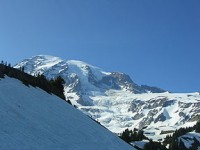
How about the fact that Emmons Glacier on Mt. Rainier is growing? How about the fact that glaciers on Glacier Peak in northern Washington are growing?
Why shouldn’t they be used as benchmark glaciers? How about the fact that glaciers are growing in Alaska for the first time in 250 years? In May, Alaska’s Hubbard Glacier was advancing at the rate of seven feet per day - more than half-a-mile per year. How about the fact that in Icy Bay, Alaska, at least three glaciers have advanced a third of a mile in one year. Why shouldn’t they be used as benchmark glaciers?
How about the fact that glaciers are growing on the tallest mountain in France? How about the fact that glaciers are growing on the tallest mountain in Canada? How about the fact that all 50 glaciers in New Zealand are growing? How about the fact that the largest glacier in Argentina is growing? How about the fact that 250 glaciers in the Western Himalayas are growing? The list goes on.
Why shouldn’t they be used as benchmark glaciers? Unfortunately, I’ve reached the point where I don’t believe what my government tells me. If it’s true that 99 percent of the thousands of glaciers in the United States are shrinking, let’s see the list. Show us the list!
Here are three of the breathless articles about the shrinking “benchmark” glaciers here, here and here. See story here.
By Craig Smith, Tribune Review
Marc Morano has spent years researching climate change along with environmental and energy issues. He traveled to Greenland in 2007 to investigate global warming claims and attended the United Nations climate eco-conferences in Kenya, Indonesia and Poland in 2006, 2007 and 2008.
Morano authored the 2007 groundbreaking report of 400-plus scientists and the follow-up 2009 report of 700-plus scientists dissenting from man-made global warming fears. Former communications director for the Senate Environment and Public Works Committee, he is executive editor of ClimateDepot.com.
We talked by phone Wednesday after U.N. Secretary-General Ban Ki-moon warned that world leaders have just four months to secure the future of the planet.
•Q: Climate Depot’s Web site broadcast the doom-and-gloom assessment from the U.N. secretary-general under the banner “Be afraid ...” You’re having some fun with this?
•A: Yeah ... the United Nations is in a panic. The Earth’s failure to warm, the number of dissenting scientists coming out of the woodwork, the countries failing to commit to the economic and emission targets that the U.N. is setting, including the big emitters like India and China. The collapse of Kyoto I. It’s turned into a joke. So we have a U.N. coming out saying we have just four months. Gee, that takes us to right around Christmas and what happens then? Oh, yes, the next U.N. conference. Would you buy a used car from someone with these kind of tactics?
The U.N. is out of control. And then if you look back to 1989, the United Nations was giving the same warning except then they gave it a little bit more time. They said we had a climate tipping point in 10 years. So by 1999 we had to act.
•Q: The Kyoto Protocol, which sets binding targets for industrialized countries and the European community for reducing greenhouse gas emissions, expires in 2012. What should happen next?
•A: The world needs to get a reality check when it comes to fears of carbon dioxide emissions. The world needs to look around at the 1.6 billion people who don’t have access to electricity and they need to look at countries like India, which said they’re not going to be part of any U.N. treaty or any part of Kyoto II because it would be immoral for them to consider restricting energy when 40 percent of their residents don’t have electricity. It is immoral to force Chad to stop burning charcoal because of global warming fears. ... People can’t heat their homes, they can’t cook. I think we need an energy initiative, not anti-energy initiatives, as we go forward and the less the United Nations has to do with that, the better.
•Q: Former EU Environment Minister Margot Wallstrom has said that Kyoto is about the economy and there’s a lot of talk about a global tax to help nations cope with global warming. Is that what this is really about?
•A: Even Sen. Claire McCaskill, D-Mo., came out this week and said it’s really not about ... the sciences, we need to do this policy. Former Democrat Sen. Timothy Wirth has said even if we’re wrong on the science of global warming, we’re doing the right thing by policy. We had Al Gore just last month announce that the congressional climate bill was the first step to global governance, echoing former French President Jacques Chirac, who said that the Kyoto Protocol was the first step toward authentic global governance. This has always been and will always be about politics. This is not about science.
•Q: We’re coming off one of the coldest Julys on record ...
•A: It’s hard to look at month-to-month variations, but yeah, we have record cold in the U.S. ... We’ve had no significant warming since ‘95 and a general cooling trend in the past few years. This has put the U.N. in a panic. Because of the number of scientists dissenting on a regular basis ... this has turned the public skeptical. Public opinion is showing dramatic growth in skepticism even among Democrats and independents at this point. ...
High school kids today forced to watch Al Gore’s film will be nearly eligible for AARP ... when warming resumes. We’re talking about a generation that won’t even know global warming other than these scary documentaries on National Geographic and watching Al Gore’s film.
•Q: To satisfy House Democrats’ low-cost solution to global warming, Americans would have to double their reliance on nuclear energy by 2030—a target the nuclear industry says is unlikely and that many environmentalists and Democrats dislike. Do you think that will fly?
•A: Even Barbara Boxer and other senators who staunchly support global warming bills have voted against ... provisions for nuclear energy. That’s how opposed they are. The same people who are worried about man-made global warming from carbon emissions are now the same people saying we can’t have nuclear. You know, in fact, The New York Times said it best: Is Jane Fonda responsible for global warming? Because her film “The China Syndrome” derailed U.S. public opinion and government policy away from nuclear. So, if we do have a global warming problem, you can lay it squarely at the feet of Jane Fonda and the anti-nuclear activists.
•Q: The cost of cutting greenhouse gases, greenhouse emissions, has been estimated at about $300 billion a year ...
•A: Yes, the U.N. calls it a phenomenal amount of money. ... Guess who’s going to be in charge of spending and overseeing the money? This is their dream. Controlling carbon dioxide is a bureaucrat’s dream. He who controls carbon controls life. And right now the U.N. is a field of dreams. These U.N. bureaucrats can think of nothing better. It’s the ultimate, ultimate control of human behavior across the globe.
We inhale oxygen; we exhale carbon dioxide. If you can regulate and declare a toxic pollutant what we exhale from our mouth, you’ve achieved a level of control George Orwell didn’t even contemplate in his book “1984.”
Read more here.
A Statement by Mr Viv Forbes, Chairman, The Carbon Sense Coalition, Australia
The Chairman of the Carbon Sense Coalition, Mr Viv Forbes, today claimed that both the Turnbull and the Wong Decarbonisation plans were “Plans for Poverty”.
Forbes explains: “The Turnbull plan aims to reduce 2020 emissions to 90% of the 2000 level. “But we have moved on from the year 2000. To get back to 90% of 2000 would require a 20% cut on today’s activities. Moreover, the population by 2020 will be at least 30% above that in 2000. So the Turnbull carbon cuts will need to be more than 33% per capita.
“Emissions are produced by everything we do - if we use electricity, steel, cement, timber, cars, trucks, planes, ships, trains or food from farms, we will always produce emissions. Even people sleeping on the beach burn carbon food energy and emit carbon dioxide. How is each Australian going to trim carbon usage by 33%?
“2020 is just a decade away. There is no chance that wind, solar, geothermal or carbon burial will overcome their technical, engineering, infrastructure, environmental, transmission, economic and stability problems quickly enough to generate significant quantities of emissions-free base load electricity in that time. “That leaves only three ways to achieve the Turnbull cuts - the Green Option, the Secret Plan or the Unspeakable Option.
“The Green Option requires less use of modern technology - a return to candles and chip heaters, wood stoves and wind pumps, charcoal burners and steam engines, sulkies and bicycles, horse power and sailing clippers, possum stew and kangaroo tail soup, mud bricks, shingle roofs and cement floors made from ant bed and cow manure. Some things will disappear unless Malcolm has plans for airships lifted by political hot air, for night-time power generated from moonbeams using lunar panels, or for vegie-steak produced from algae growing in backyard ponds of poo.
“Reducing population will definitely achieve cuts in emissions without cuts in living standards. Is that the Secret Plan? “Or of course we always have the Unspeakable Option - a crash program to build nuclear power plants in the Latrobe, the Hunter, the Barossa, the Fitzroy and the Pilbara.
“Compared to these options, maybe a bit more harmless carbon dioxide in the atmosphere is not so bad after all?” The Wong plan and the Turnbull plan are Plans for Poverty. “Both should be rejected.”
Viv Forbes
info@carbon-sense.com
Chairman, The Carbon Sense Coalition
See also how KEVIN Rudd’s plans for an early double dissolution election have been sunk, with the discovery of a legal defect in his Emissions Trading Scheme. The Clerk of the Senate, Harry Evans, is understood to have confirmed that even if Mr Rudd were to go to a double dissolution election to get his ETS through Parliament, the scheme could still be blocked by the Senate.
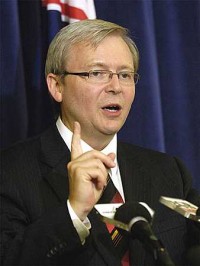
Kevin Rudd
Story here.
Also see video here.
By Jerry Taylor
The August 4 issue of the New York Times features a rather illuminating article by Andrew Revkin - the Times’ climate reporter - on sentiment within the ranks of the IPCC as that organization begins work on its upcoming 2014 report. Revkin reports that the IPCC’s scientists are frustrated that the world’s governments - even those that are led by politicians who habitually give end-is-near speeches about global warming - are not taking the sorts of policy actions the organization thinks are necessary to head-off global catastrophe. Hence, a growing number of scientists want the IPCC to be more explicit and prescriptive with regards to public policy, less inhibited when discussing scientific issues where a great deal of uncertainty exists, more concerned with best practices pertaining to public risk management, and more politically sensitive about the issues that are examined at-length in the upcoming report.
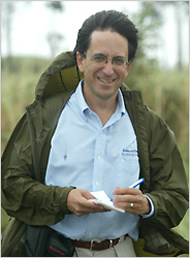
In other words, Revkin reports that the IPCC wants to spend less time on science in their next report than they have in past reports and more time on issues for which it has no relevant expertise or comparative advantage. Of course, Revkin doesn’t put it quite that way, but that’s the unmistakable implication of what he reports.
Consider these complaints one at a time.
The fact that governments are not fundamentally transforming society to address climate change is not necessarily a sign that either the public or their governmental representatives are not listening closely enough to the IPCC. Public resources are, after all, rather limited. There is only so much time, energy, and money to address real, imagined, or potential public harms. Hence, worries about climate change have to compete with worries about AIDS, economic development, terrorism, unfunded public health care and retirement programs, the global economic recession, and numerous other things.
Scientists who specialize in climate change have no comparative advantage in sorting out which of these worries are more important than others. In fact, there is very good reason to think that climate change is less important than more than a dozen other issues affecting human wellbeing even if one buys the scientific arguments found in past IPCC reports.
Moreover, crafting “good” public policy (defined as policies that maximize the spread between benefits and costs, broadly understood) is a difficult undertaking. Political scientists and economists are trained in this sort of thing. Scientists are not. See more here.
By Vincent Gray, New Zealand Climate Truth Newsletter
Every time there is a Pacific Islands Forum they trundle out once again the conventional lies to draw attention away from the real issues. The claim always is that the main issues are “Climate Change” and the threat from sea level rise. I have dealt many times with these issues, but they do bnot take a blind bit of notice, so here goes yet again.
There is the usual failure to understand that the climate is always changhing and always will. For a small bribe it is always possible to find people to testify that the climate is changing, Why, we actually had a hurricane recently! It is an unfortunate and inevitable feature of the climate in the Pacific islands that they have occasional hurricanes. They always have. There is absolutely no evidence that they are more frequent now than in the past, and there is even less than no evidence that they are caused by increases of greenhous gases in the atmosphere, or that reducing these will have any effect. Yet they persist in tryng to claim otherwise.
But it is the evidence on sea level that is persistently ignored. Instead of consulting this evidence we again have intrerviews with people, who for a small fee will testify that last week the sea came a bit higher.
The evidence that the sea level in all of the Pacific islands is not changing is, to coin a phrase, unequivocal. It is based on the most comprehensive study ever made of a small area.You should realise that most historic measurements of sea level have atendency to be upwardly biased for a whole variety of reasons, The equipment is battered by the sea, particularly in a hurricane and tends to be displaced downwards. The land subsides from the weight of additional buildings, and fvrom theremovbal of ground water and minerals. The correction, which is sometimes made, for “isostasy”, geological movement, is frequently inadequate.
Many of these problems were avoided by the Pacific Island Sea Level Project which was launched by the Australians in 1991, using scientists from Flinders University, Adelaide. The design of the SEAFRAME equipment was state-of-the-art. It is illustrated in the attachment. Notice that it is kept level by GOPS equipment, something that was missing in all historic equipment.
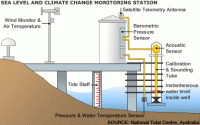
Enlarged here.
This equipment was installed on 12 Pacific islands in the following groups: Marshall Islands, Federated States of Micronesia, Papua New Guinea, Solomon Islands, Kiribati, Nauru, Tuvalu, Samoa, Vanuatu, Fiji, Tonga, and the Cook Islands.
There have been annual reports of progress for each of the islands. These also contain information on sea level change from other equipment covering many mother islands. There is an additional report from Niue. The latest reports can be seen here.
A general write up of the project can be found here.
The attached graph appears in all of the reports and shows monthly changes at all of the SEAFRAME sites.
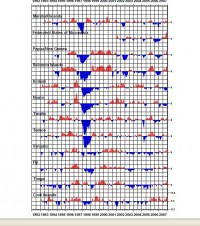
It is clear from this graph that there has been no change in sea level at any one of the sites since the start, which for most goes back to 1992. This is, surely, unequivocal.
Every record was interrupted in 1998 by a hurricane which gave a spurious low reading. I say spurious beacause I do not believe that the actual level of the sea fell at all, but the turbulence created by the hurrticane around the measuring equipment prevented the establishmenty of a sensible average.
This event, has, however, been welcomed by the authors of each report and by all the politicians involved, because it enables the excuse to claim that it causes the desired upwards “trend” which is lovingly presented in all the reports. So everybody can claim that the sea level is actuallly rising, however slowly, so people might beliieve the absurd “projections” of the Climate modellists.
Oregon State University release on Watts Up With That
A team of researchers says it has largely put to rest a long debate on the underlying mechanism that has caused periodic ice ages on Earth for the past 2.5 million years - they are ultimately linked to slight shifts in solar radiation caused by predictable changes in Earth’s rotation and axis.

The above image shows how much the Earth’s orbit can vary in shape. This process in a slow one, taking roughly 100,000 to cycle. (Credit: Texas A&M University)
In a publication to be released Friday in the journal Science, researchers from Oregon State University and other institutions conclude that the known wobbles in Earth’s rotation caused global ice levels to reach their peak about 26,000 years ago, stabilize for 7,000 years and then begin melting 19,000 years ago, eventually bringing to an end the last ice age.
The melting was first caused by more solar radiation, not changes in carbon dioxide levels or ocean temperatures, as some scientists have suggested in recent years. “Solar radiation was the trigger that started the ice melting, that’s now pretty certain,” said Peter Clark, a professor of geosciences at OSU. “There were also changes in atmospheric carbon dioxide levels and ocean circulation, but those happened later and amplified a process that had already begun.”
The findings are important, the scientists said, because they will give researchers a more precise understanding of how ice sheets melt in response to radiative forcing mechanisms. And even though the changes that occurred 19,000 years ago were due to increased solar radiation, that amount of heating can be translated into what is expected from current increases in greenhouse gas levels, and help scientists more accurately project how Earth’s existing ice sheets will react in the future.
“We now know with much more certainty how ancient ice sheets responded to solar radiation, and that will be very useful in better understanding what the future holds,” Clark said. “It’s good to get this pinned down.” The researchers used an analysis of 6,000 dates and locations of ice sheets to define, with a high level of accuracy, when they started to melt. In doing this, they confirmed a theory that was first developed more than 50 years ago that pointed to small but definable changes in Earth’s rotation as the trigger for ice ages.
“We can calculate changes in the Earth’s axis and rotation that go back 50 million years,” Clark said. “These are caused primarily by the gravitational influences of the larger planets, such as Jupiter and Saturn, which pull and tug on the Earth in slightly different ways over periods of thousands of years.”
That, in turn, can change the Earth’s axis - the way it tilts towards the sun - about two degrees over long periods of time, which changes the way sunlight strikes the planet. And those small shifts in solar radiation were all it took to cause multiple ice ages during about the past 2.5 million years on Earth, which reach their extremes every 100,000 years or so.
Sometime around now, scientists say, the Earth should be changing from a long interglacial period that has lasted the past 10,000 years and shifting back towards conditions that will ultimately lead to another ice age - unless some other forces stop or slow it. But these are processes that literally move with glacial slowness, and due to greenhouse gas emissions the Earth has already warmed as much in about the past 200 years as it ordinarily might in several thousand years, Clark said.
“One of the biggest concerns right now is how the Greenland and Antarctic ice sheets will respond to global warming and contribute to sea level rise,” Clark said. “This study will help us better understand that process, and improve the validity of our models.” The research was done in collaboration with scientists from the Geological Survey of Canada, University of Wisconsin, Stockholm University, Harvard University, the U.S. Geological Survey and University of Ulster. It was supported by the National Science Foundation and other agencies.
Scientific Alliance Newsletter, August 7, 2009
There are two alternative ways to look at how science progresses. In one corner is the concept of the falsifiable hypothesis, credited to Karl Popper. Popper argued that all science is based on hypotheses, which must be tested to destruction. Sound evidence which does not fit with the hypothesis must logically cause it to be rejected. However, the other side of the same coin is that no hypothesis can ever be said to be proven. Over time, the body of evidence consistent with a successful hypothesis builds up to the extent that it becomes regarded as a theory, for example the theory of General Relativity, or Tectonic Plate theory.
At this stage, theories are treated, to all intents and purposes, as fact. However, even then, quite basic knowledge may, with time, be seen as merely provisional. A classic example is Newtonian mechanics, which fully describes the motion of bodies on the scale we are familiar with, but which breaks down both at the level of elementary particles (hence the development of quantum mechanics) and at a cosmological scale (where relativity comes into play).
Popper used the concept of falsifiability as his criterion for whether something is genuinely scientific or not. Thomas Kuhn, in the other corner of this contest, contributed a different view of how scientists work. He introduced the concept of “normal science” to cover the situation where scientists work on various topics within a central paradigm. In contrast to Popper, the Kuhnian view is that “wrong” results (ie, those which are in conflict with the prevailing paradigm) are considered to be due to errors on the part of the researcher rather than findings which jeopardise the consensus view. However, as conflicting evidence increases, a crisis point is reached where a new consensus view is arrived at: a so-called paradigm shift.
These two philosophical approaches represent the extremes of a spectrum. Popper is the purist, who describes how scientific progress ought to work in an ideal world. On the other hand, Kuhn’s description is more pragmatic and a more realistic view of what actually happens. When a hypothesis is first put forward, it would be quite easy to discard it if early experimental results falsified it. However, when a consensus builds up over time that a particular view is “correct”, it takes plenty of hard evidence to convince people they have been wrong. After all, scientists are only human.
The example often used of this happening in the fairly recent past was the derision which was directed at Wegener’s hypothesis of continental drift, when the prevailing scientific view was that land masses were immobile. Although there were some supporters of this view during the first half of the twentieth century, it was only in the 1950s that an understanding of plate tectonics led to the general acceptance that continents are not static. This was a revolutionary shift in thinking, but the paradigm took many years to change.
But Popper’s description was more nearly correct in the case of cosmology. In the 1950s, there were two competing primary models of the Universe: the Big Bang and the Steady State. By the mid-60s, the accumulation of evidence led most astronomers to accept that the Big Bang was the hypothesis which gave the better explanation of how the Universe behaves.
Coming now to the more topical and contentious case of climate change, it is clear that science is operating in a Kuhnian fashion. There are a number of observations which would apparently serve to falsify the hypothesised enhanced greenhouse effect. Not least of these are the missing signature of CO2-driven warming (an enhanced rate of warming in the upper troposphere relative to the Earth’s surface) and the lack of warming across the greater part of Antarctica. The response to this - from those who do not simply dismiss the evidence out of hand - is to point instead to evidence which is consistent with the AGW hypothesis and to introduce a range of fudge factors such as aerosols to account for the observed lack of correlation between atmospheric carbon dioxide level and average temperatures.
The behaviour of a great many researchers involved in climate change is far from Popperian. Rather than test their hypothesis by trying to falsify it, they look instead for evidence which supports it and, in a deeply unscientific manner, will often simply dismiss contrary evidence on the basis of minor flaws or criticism. This is research done according to prejudice rather than with an open mind. To compound the error, and because evidence can only be gathered by observation rather than experiment, increasing reliance has been placed on computer models.
Making headlines in the Guardian last week was a study not yet even published. Jointly written by Judith Lean of the US Naval Research Laboratory and David Rind of the NASA Goddard Institute for Space Studies and due to appear in Geophysical Research Letters, this is billed as the first analysis of the combined impact of human influences (including CO2 and aerosols), solar radiation, volcanic eruptions and ENSO (the El Nino Southern Oscillation) on global temperatures. Their main conclusions are that anthropogenic global warming has been masked in recent years by reduced solar activity and a lack of a strong positive El Nino, but that a projected increase in solar activity will cause temperatures to rise at a rate 50% faster than projected by the IPCC. Many readers will of course remember that mainstream researchers have generally downplayed the role of variations in the Sun’s output as insignificant in terms of global temperatures, but there now seems to have been a reinterpretation to fit the facts.
But the main criticism of this paper (or at least, what has been reported prior to publication) is that it is not a scientific study but the output of a computer model. The study smacks of damage limitation, of a desire to find some rational explanation for the lack of temperature rise over the past seven or more years. The explanation is that well, yes, natural variation can be important, but that this is only creating a temporary masking effect, soon to disappear. Suspicions about the motivation for the paper are only increased by the Guardian headline: “New estimate based on the forthcoming upturn in solar activity and El Nino southern oscillation cycles is expected to silence global warming sceptics”.
Highly unlikely, as this is merely hypothesis and, crucially, it is not directly falsifiable. But what is important is that the authors are predicting the return of global warming in the next few years, and that the upward trend will be higher than before. If this does not occur, then we must conclude that their analysis is wrong. If they are wrong, it may be because the coming solar cycle will be a weak one, as many people are predicting. And, if so, the logical conclusion may be that natural cycles are more important than carbon dioxide emissions.
In the meantime, Henrik Svensmark and colleagues from the Danish National Space Centre have published a paper in the same journal which gives support for the hypothesis that cosmic rays, modulated by the solar wind, can indeed alter the degree of cloud cover and hence affect temperature (Svensmark et al; Cosmic ray decreases affect atmospheric aerosols and clouds; Geophysical Research Letters; Vol 36, L15101, doi:10.1029/2009GL038429, 2009). Their measurements indicate that cloud cover measured over oceans decreases to a minimum approximately a week after cosmic ray minima. The effect can take large quantities of liquid water out of the atmosphere. This hypothesis may or may not be right, but it remains a working possibility and should certainly not be dismissed lightly.
So, climate science, heavily influenced by global warming politics, continues to adhere to a central paradigm as described by Kuhn. Contrary evidence is clearly not going to be accepted as falsification. It will be fascinating to see what trends there actually are in climate over coming years and, if the predictions of renewed (and faster) global warming come to nothing, then what else will be necessary to cause the crisis which will lead to a paradigm shift. In the meantime, we have to hope that politicians do not take us too far down the road of trying to control the climate based on the current paradigm.
Guest Post by Nicola Scafetta on Climate Science Blog
Roger Pielke Intro: On July 22 2009 I posted on the new paper on solar forcing by Lean and Rind 2009 (see). In that post, I also referred to the Benestad and Schmidt 2009 paper on solar forcing which has a conclusion at variance to that in the Lean and Rind paper.
After the publication of my post, Nicole Scafetta asked if he could present a comment (as a guest weblog) on the Benestad and Schmidt paper on my website, since it will take several months for his comment to make it through the review process. In the interests of presenting the perspectives on the issue of solar climate forcing, Nicola’s post appears below. I also invite Benestad and Schmidt to write responses to the Scafetta contribution which I would be glad to post on my website.
GUEST WEBLOG BY NICOLA SCAFETTA
Benestad and Schmidt have recently published a paper in JGR. (Benestad, R. E., and G. A. Schmidt (2009), Solar trends and global warming, J. Geophys. Res., 114, D14101, doi:10.1029/2008JD011639).
This paper criticizes the mathematical algorithms of several papers that claim that the temperature data show a significant solar signature. They conclude that such algorithms are “nonrobust” and conclude that “the most likely contribution from solar forcing a global warming is 7 plus or minus 1% for the 20th century and is negligible for warming since 1980.”
By using the word “robust” and its derivates for 18 times, Benestad and Schmidt claim to disprove two categories of papers: those that use the multilinear regression analysis [Lean and Rind, 2008; Camp and Tung, 2007; Ingram, 2006] and those that present an alternative approach [Scafetta and West, 2005, 2006a, 2006b, 2007, 2008]. (See the references in their paper.)
Herein, I will not discuss the limitation of the multilinear regression analysis nor the limits of Benestad and Schmidt’s critique to those papers. I will briefly focus on Benestad and Schmidt’s criticism to the papers that I coauthored with Dr. West. I found Benestad and Schmidt’s claims to be extremely misleading and full of gratuitous criticism due to poor reading and understanding of the data analysis that was accomplished in our works.
Benestad and Schmidt’s paper is full of misleading claims that they are reproducing our analysis. Indeed, Benestad and Schmidt’s paper is self-contradictory on this crucial issue. In paragraph 85 Benestad and Schmidt claim that they “have repeated the analyses of Scafetta and West, together with a series of sensitivity tests to some of their arbitrary choices.” However, in their paragraph 76 Benestad and Schmidt acknowledge: “In our emulation, we were not able to get exactly the same ratio of amplitudes, due to lack of robustness of the SW06a method and insufficient methods description.” It is quite singular that Benestad and Schmidt claim to have repeated our calculation, at the same time they acknowledge that, indeed, they did not succeed in repeating our calculation and, ironically, they blame us for their failure. It is not easy to find in the scientific literature such kind of tortuous reasoning!
In fact, the reason why Benestad and Schmidt did not succeed in repeating our calculation is because they have misapplied the wavelet decomposition algorithm known as the maximum overlap discrete wavelet transforms (MODWT).
See figure below where I compare Benestad and Schmidt’s figures 6 and 7 and show that the results depicted in their Figure 7 are non-physical.
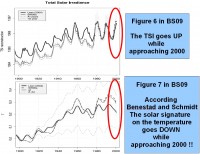
See larger one here.
Because of the severe and naive error in applying the wavelet decomposition, Benestad and Schmidt’s calculations are “robustly” flawed. I cannot but encourage Benestad and Schmidt to carefully study some book about wavelet decomposition such as the excellent work by Percival and Walden [2000] before attempting to use a complex and powerful algorithm such as the Maximum Overlap Discrete Wavelet Transform (MODWT) by just loading a pre-compiled computer R package.
There are several other gratuitous claims and errors in Benestad and Schmidt’s paper. However, the above is sufficient for this fast reply. I just wonder why the referees of that paper did not check Benestad and Schmidt’s numerous misleading statements and errors. It would be sad if the reason is because somebody is mistaking a scientific theory such as the “anthropogenic global warming theory” for an ideology that should be defended at all costs.
Read full post here. Read more from Steve McIntyre on Climate Audit on BS09 here.




